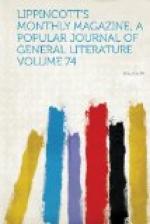The canal over which I am now conducting my readers is one of the oldest in the country. For many miles it is cut out of the solid rock, following the windings of the river and clinging close to the contours of the hills. The particolored rocks jut out in great square blocks, which, in summer, are usually tufted with grass or flowers. There is an indescribable air of coziness and safety about the amphibious life one leads on such a canal. You can here snap your fingers at the terrors of the cruel water. Here the mocking waves cannot “curl their monstrous heads” as on the sea, when with blind fury they dash against the helpless ship their ponderous and shapeless forms, while sailors and passengers alike are every moment expecting the final stroke that shall sink them beneath the waves. On the canal you cannot be drowned, on the canal you cannot be wrecked. The shore is so delightfully near! You exult in the friendly companionship of the rocky wall that towers above you, and in the assuring presence of the flowers and shrubs that cling there or reach out to you their thin elvish hands. You feel that here untamed Nature (that great wolf) cannot get her claws upon you. Upon this thread of water you are soothed by the thought that you are under the friendly and beneficent protection of man.
About nine or ten o’clock each evening the boats tie up at some lock. At all of these locks there are refreshment-stands and neat taverns of which the traveller must avail himself, since there are no accommodations for visitors on the boats. On the fourth day, wishing to vary my experience, I boarded another boat. Her deck was the very model of neatness. Verily the spirit of either a Yankee housewife or a Dutch vrow must have presided over that boat and tyrannized over the poor wretches who managed it. Black Care seemed to sit continually upon their brows. They were living scrubbing-brushes. They were scrub-mad. From morn to dewy eve they scrubbed and scrubbed and scrubbed, and doubtless in their dreams they still scrubbed on. The crew consisted of a man and his wife, their boy and an old uncle of the boy. I found, to my delight, that the boy was a very communicative young gentleman, flowing freely in talk without any pumping on my part. The various quaint technical phrases which I learned from him shall now be imparted to the reader. The berme, or heel-path, is the side of the canal opposite the tow-path; basins are small coves in the canal where boats may lie over; stop-lock, a sort of quay; the bit, a timber-head at the bow of the boat. Snub her! is a phrase of command, meaning, “Tie the boat to a post on the bank.” Pipe-poles are steering-poles. The stern pile (of coal on this canal) is in a large crib near the stern and just in front of the cabin, and is placed in this particular part of the long and unwieldy boat in order to make her obey the helm better. Timber-heads project above the deck to “snub” lines on. Tow-posts are short upright posts near the bow, to which the tow-line is fastened. The combings are the pieces the hatches rest on and surround the hold in an oval form. The wale-plank is the edge of the deck, projecting out over the water like a welt around the entire circumference of the boat.




